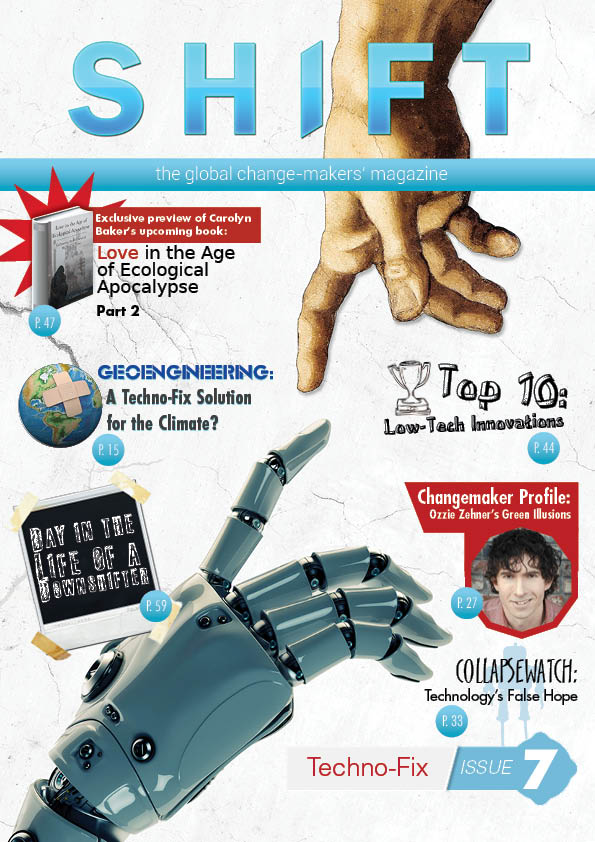
The Labour-Saving Paradox
It is widely believed that our use of tools is what separates humans from the rest of the animal kingdom – one of those things that makes us unique, special, superior even. Our use of tools amplifies the effect of using our own energy to complete a task, kitting us out with an evolutionary advantage.
Humans are far from the only species to make use of tools, however; in fact, energy-amplifying tool use is widespread throughout the animal kingdom – from chimpanzees’ use of rocks to crack open nuts, to crows’ use of twigs to ‘fish’ for insects, to alligators’ use of sticks to lure and trap prey. Tool use, far from being a uniquely human trait, appears to be boringly standard in the animal kingdom.
Using energy to save energy
The labour-saving devices we have come to depend on in the modern world are simply another means of harnessing energy from outside of our own bodies to amplify the effects of using our own energy to complete a task. But technological development is subject to diminishing returns on investment, meaning that each new upgrade saves less time and energy than the previous one, while continuing to deplete resources, including non-human energy. We may have reached a plateau in innovative absurdities that save next to no time and expend vast amounts of energy – think leaf-blowers in lieu of rakes, dispersing leaves instead of collecting them, thus ensuring a rinse-n-repeat cycle of the same work – and dishwashers that require you to rinse your dishes before stacking.
Thus tool use as we know it today seems to have become an end in itself, rather than simply a means to an end, with new technologies often justifying their existence less in terms of time and energy saved, and more in terms of representing an abstract set of values: the higher the tech, the better the ‘progress’. This is good news for corporations and investors, but less so for the hip-pocket and the environment, and we are left wondering when enough will be enough.
Saving ourselves labour through harnessing external energy makes sense if we are to enjoy leisure time, opportunities for learning and creativity, and close connections with family and community; but are we making the most of these opportunities? And are they worth the cost?
A brief history of energy
A turning point for humankind that has really set us apart from the rest of the animal kingdom is our use of fire, which we first harnessed to our advantage about a million years ago. Our use of fire meant that we could cook food, which enabled us to unlock stores of energy and nutrition from nutritionally and calorie-dense food sources previously inaccessible to us, such as grains. The ability to consume more calories with less work freed us up to spend time on pursuits beyond basic survival, as well as making more energy available to our brains, thus fuelling their growth.
Fire also enabled humans to keep warm, thus expanding the range of locations where humans could survive – allowing us to migrate away from the tropical birthplace of our species, as well as survive ice ages. And fire gave us an advantage over other species, particularly when it came to hunting and securing our safety from predators (with the unintended consequence of jump-starting the sixth mass extinction by killing off the apex predators of each continent we settled).
Fire also enabled us to unlock vast stores of energy-dense fossil fuels, which brought us to another turning point in the history of humankind. Burning coal, oil and natural gas has resulted in a bonanza of ‘free’ energy – energy that we can take from the environment without having to pay back – and we have used it to extract, process, manufacture, and sell a vast range of previously unimagined desires. But there is no such thing as a free lunch – we can only delay paying the tab.
Prior to the hydrocarbon-fuelled growth era, humans expended a great deal more of their own energy to achieve far more modest accomplishments, and in cases where a great deal needed to be done in a short amount of time, slave labour was rationalized for the sake of ‘human progress’. Indeed it was slave labour that leveraged the United States to its current economic superpower status. Supplementing our energy requirements with fossil fuels has enabled human populations to industrialize and move away from the subsistence agriculture that occupied most people prior to the dawn of the industrial era – and the introduction of ‘energy slaves’ (of which the average American has about 100) has rendered human slaves almost obsolete.
This move away from land-based living to industrialization also enabled the human population to grow far beyond the carrying capacity of our landbases, and to own far more ‘stuff’ – both essential factors in the capitalist ownership model and modern-day growth economics. We now live in increasingly large homes, own ever more stuff, and travel increasingly large distances, and our one-size-fits-all approach to problem-solving sees us introducing tools to take some of the consequent extra work off our hands, rather than downsizing and downshifting to save ourselves all the extra work. It seems we’re stuck in an entropic vicious cycle of expending energy to save energy.
Peak oil = peak labour-saving
Richard Heinberg’s October 2012 Museletter featured a submission to the Sydney Morning Herald (which the paper declined to publish), in which he brings into perspective the labour-saving qualities of petroleum:
“Think of it this way. You have run out of petrol and have to push your car a couple of metres off to the side of the road. It’s a lot of work, especially if it’s a heavy car. Think about having to push the car for kilometre after kilometre – that would really be a lot of work. If you do the math, a single litre of fuel is doing the work that’s the equivalent to, maybe, six weeks of hard labour. You can’t get labour anywhere as cheap as the petrol we buy.”
The last time I tanked up the car petrol was AU$1.19 per litre. This week it’s AU$1.07, thanks to peak oil’s deflationary spiral. Six weeks of hard labour for $1.19 – or $1.07 – is laughable, yet we take it for granted when it comes to our labour-saving machines, our energy slaves.
Much of what we currently consider necessary to our survival will make only a fleeting appearance in the grand scheme of human experience. Almost all of the trappings of modern industrial society are 150 years old or less, and are impossible to maintain on anything like the scale we are used to with diminishing oil. The more fossil energy we’ve put into saving ourselves a bit of hard work, the more quickly we’ve used up that stored energy, thus hastening our return to having to do those hard yards ourselves, without the luxury of the labour-saving devices we’ve grown so accustomed to.
Peak oil, often misunderstood as the point at which oil runs out, is the point at which oil production reaches its peak, before its inevitable decline. Make no mistake: this decline is inevitable simply due to oil’s finite nature – no technological or market-engineered fix can render peak oil moot; such fixes can only delay the inevitable. And, as Ozzie Zehner points out in his timely book, Green Illusions, renewable energy is no knight in shining armour – instead it piggybacks on the fossil energy required to mine, process, manufacture and distribute the resources that make it possible. Post-peak decline in oil production will impair our ability to conduct business as usual, or, indeed, any business at all. Analysts vary in their estimates of when peak oil will be, or has been, reached, and a commonly cited date is 2005 – which makes sense to those with a finger on the oil-price pulse, as prices spiked sharply following 2005, and were at least partially responsible for the global financial crisis that struck in 2008 and the resulting deflationary nosedive we see today. Oil’s peak appears to be behind us; we’ve begun our bumpy descent.
Perhaps an even more relevant factoid would be the date of peak oil per capita. If we take the date of peak oil as 2005, then it is reasonable to expect that 2005 not only saw the highest point of oil production, but that the highest standard of living ever known to humankind would have followed in its wake. Not so. For this to have been the case, human population would have to have remained stable since the discovery of oil; instead it has grown more than 5-fold since oil exploitation began in earnest in 1848, in Baku, Azerbaijan, the once-thriving birthplace of the modern oil industry, now a post-peak ghost town. The multiplier effect of population growth has startling consequences. The estimated date of peak oil per capita was 1979, suggesting that even though many regions of the world will not have noticed an appreciable drop in standards of living, others have inequitable distribution of this most valuable of resources to thank for their increased poverty.
The future holds a drop in living standards for all, thanks to the descent from oil’s slippery peak, but this drop will not be equitably distributed. The wealthiest will be the last to feel the impact when we hit bottom, while the poorest will simply never learn what it is like to harness the wonders of technology’s energy slaves for their own benefit.
Labour-saving irony
While the window closes on the fossil-fuelled labour-saving era shouldn’t we just continue to make the most of the opportunities our energy slaves afford us? Well it’s far from certain that we do make the most of these opportunities. The car, that ever-ready symbol of modern, industrial society, provides an excellent case in point.
Despite the car’s obvious ability to save us time and work, it has not liberated us as much as caused us to become dependent on it, as Michael and Joyce Huesemann explain in their book, Techno-Fix. Life in the suburbs may have been made possible by car ownership, but the majority of its inhabitants are now dependent on cars for commuting to work and accessing basic services. If the car were the labour-saving exemplar it is held up to be, we would just use it to cover the short distances we used to cover on foot, and no more, saving ourselves time to spend on other pursuits; but as the Jevons Paradox would have it, instead of saving ourselves time, we tend to squeeze more labour out of our labour-saving machines. In this way, commuting has become a norm, and it has massively altered our way of life, adding to the energy requirements of business as usual. If the many hidden costs and unintended consequences of car usage – road construction and maintenance, soil, air and water pollution, carbon emissions, and military defense of oil supplies, for example – were accounted for in the cost of petrol consumption, then petrol would cost four times as much as it does; life in the suburbs would become unaffordable for many who currently enjoy it.
The Huesemanns have also come up with an interesting calculation of how much time and labour car ownership really saves. After calculating the total average cost of owning and operating a vehicle over the space of a year, and dividing it by the median net income, they found that the average American worker spends 35% of their income on car transportation expenses, or 760 working hours per year. Adding to this the time spent commuting – so a total of 1,125 – 1,307 hours of car-related work-time – divided by the distance covered, Americans squeeze an average of 9.0 – 10.4 miles per hour spent on their cars. Admittedly this is faster than walking, but not as impressive as a cruising pace on a bicycle.
Women’s work
In The End of Growth, Richard Heinberg writes that the post-peak oil era could see a return of women to work centered primarily in the home – thanks to the loss of labour-saving capacity in what is traditionally considered ‘women’s work’. This translates to a consequent reduction in women’s rights and opportunities. In the absence of techno-fix potential, efforts to avoid this regression will have to be political in nature, not technological.
In his 2010 TED talk (TEDWomen), ‘data visionary’ Hans Rosling asserts that the washing machine is the one technological innovation that has been of greatest benefit to women. 5 billion of the world’s 7 billion (in 2010) people have electricity in their homes, yet only two billion of these people live above what Rosling refers to quaintly as the ‘wash line’, leaving 5 billion beneath it. Rosling argues that it is the washing machine that has made all the difference to women because its labour-saving role freed its female owners up from hours and hours of laundry each week (which is unquestionably women’s work, apparently, even at TEDWomen), enabling them instead to get an education. His conclusion is that we should improve the lot of women globally by facilitating ownership of such labour-saving devices – not just washing machines – for the other 5 billion, and not to worry about the environmental impact because we can power it all with renewable energy. Aside from Rosling’s obvious errors in comprehending the finite nature of our planet, this is a classic example of a correlation-does-not-equal-causation error.
Omitted from Rosling’s talk is the fact that women with access to education largely have social class to thank for the privilege (in which case it is unlikely their alternative life would feature hours of domestic drudgery each day), and the immense strides made by the women’s movement in making education accessible to more women. Also omitted are the strides in achieving reproductive sovereignty for women, enabling women to choose how many children they have, and when they have them, empowering women, therefore, to control their domestic workload. Also omitted are the strides in addressing the ‘dual burden’ of women in the workplace and the home, the baby steps that have been made to bring men into the domestic sphere to share the load.
Such political factors ought not be played down in order to attribute positive effects only to technological innovations. Instead they need to form the backbone of future efforts to achieve fairness and equity in living standards.
One thing Rosling didn’t neglect to mention in his TED talk, however, was that the washing machine that enabled his mother to get an education, and find the time to read to him when he was a child, had cost his family dearly in the time it took to save the money to buy the machine and operate it. One wonders how much time and labour were really saved over all – if, perhaps, the time taken working for the money to buy and operate the machine could have been spent learning, and reading to children. The notion that this time was available thanks to the machine itself is a myopic view, when one takes into account the various ways in which one could actually save time and labour, and the externalities involved in production of labour-saving devices.
This is not to suggest, of course, that we should all stop using washing machines and quit our jobs (although I confess to having done both, and have time to devote to the degrowth movement as a result). Rather my point is that while it is arguably true, to an extent, that having more time on their hands enabled women to access new opportunities, it is not true to claim that these opportunities came about solely thanks to labour-saving devices. We need to think outside the tool-box.
Thinking outside the tool-box
As Richard Heinberg explains in The End of Growth,
“All of the solutions to our growth-based problems involve some form of self-restraint.”
Our tool-box is overflowing, but our repertoire of alternative solutions to our problems remains largely untapped. Curbing resource consumption and population overshoot implies the self-restraint of commitment to degrowth and downshifting, whose rewards include more time on our hands for the finer things in life: family, friends, leisure, creativity, and learning.
We are unlikely to overcome our desire to save ourselves labour – it is a characteristic ubiquitous in the animal kingdom. But we do need to accept that we cannot continue to develop labour-saving technologies until we are reduced to the idle hedonists depicted in Pixar’s WALL-E, in which humans no longer need to lift a finger thanks to robots. Even if such an end-point were energetically possible, the Jevons Paradox suggests that without a fundamental change in our economic system, we’ll just continue to use technology to produce more stuff, rather than to save ourselves work.
The degrowth movement therefore bears striking similarity to the abolitionist movement – the movement to abolish slavery – in that much as the abolitionists were maligned by the exploiters of slaves, degrowthers are often mocked by the exploiters of fossil energy for being luddites against ‘progress’. Of course degrowth is as much of a threat to profit-motivated industrial capitalists as abolition was to slave-exploiting plantation-owning capitalists; but to the majority, degrowth offers the opportunities for reduced workloads and increased leisure time that labour-saving devices have paradoxically eluded.
Humans are more than the one-trick pony our obsession with technological fixes depicts us as. We are adaptable, and have the capacity to approach our problems from a variety of angles. We also have the capacity to exercise restraint when necessary. And we can break the cycle of the labour-saving paradox, if we think outside the tool-box.
Further reading: If this article has piqued your interest, the following books may be of interest to you for further reading:- Green Illusions, by Ozzie Zehner
- Techno-Fix, by Michael Huesemann & Joyce Huesemann
- The End of Growth, by Richard Heinberg


















Linked to this article:
Pingback: The Labour-Saving Paradox | The Overthinker